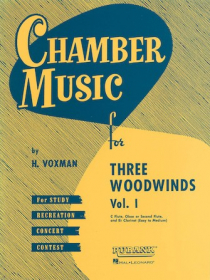Woodwind Trio
-
-
Alain, J :: Invention a Trois Voix [Invention for Three Voices]
Invention a Trois Voix [Invention for Three Voices]
Alain, J
Invention a 3 Voix [Invention for 3 Voices] -
Anderson, DJ :: Nightfall
Nightfall
Anderson, DJ
For Flute, Clarinet and Bassoon. A short, simple ensemble piece for nightfall: a time when the day's duties and cares retreat to the background.
-
-
Azevedo, S :: Serenata alla Madrigalesca
Serenata alla Madrigalesca
Azevedo, SSergio Azevedo's Serenata alla madrigalesco, for flute, oboe, and clarinet in Bb, is a three-movement work threaded with a healthy does of neo-romanticism. Written in the best sense of the wind trio - with each instrument displaying their colors at their best, and with tight but rich interplay - the Serenata is both audience-pleasing and one of those works that is a true pleasure to play.
For advanced players.
-
Azevedo, S :: Serenata em trio
Serenata em trio
Azevedo, SSergio Azevedo presents Serenata em Trio for flute, oboe, and clarinet in Bb. In three movements and of substantial length, this is a particularly intriguing and effective addition to the repertoire.
-
Bach, JS :: Air For The G String
Air For The G String
Bach, JSMusicians Publications presents J.S. Bach s Air For The G String arranged for woodwind trio by Bill Holcombe and Bill Holcombe Jr. Scored for flute, oboe or clarinet, and bassoon or bass clarinet, this arrangement is intermediate in difficulty and 3:35 in duration. What s interesting about this edition, is that it contains two versions of the work: one in the original key of D major and another in F major.
Air is a piece from Bach s Third Orchestral Suite in D Major, BWV 1068. The Third Suite may be the most famous of the four on account of its meltingly beautiful Air. One of the most popular and arranged pieces of all time, it achieved special notoriety through August Wilhelmj s version for the violin G string (1871). The Air s binary form two halves, each repeated and its stepping bass overlaid with a long, sustained melodic line are standard Baroque procedures, but its poignant effect transcends all formulas. - Jane Vial Jaffe
-
Bach, JS :: Arioso
Arioso
Bach, JSMusicians Publications presents J.S> Bach s popular 'Arioso' arranged for flexible woodwind trio by Bill Holcombe and Bill Holcombe Jr. This arrangement includes two versions: a solo version and a soli version. This arrangement includes a plethora of woodwind parts that are interchangeable depending on the instrumentation available. The score is divided into 3 voices, with the lowest voice in both bass and treble clef. Voice 1 parts include flute, oboe, and clarinet; upper voice 2 parts include flute, oboe, and B-flat clarinet; and voice 3 parts include clarinet, bass clarinet, or bassoon. The many different options in performance make this the perfect medley for a gigging group! It is advanced in difficulty.
-
Bach, JS :: Bouree
Bouree
Bach, JSMusicians Publications presents J.S. Bach s Bouree from his Six Suites for Viola da Gamba, No. 3. Scored for flute, oboe, and clarinet, this arrangement also includes an optional clarinet part to replace the oboe if necessary. This arrangement is advanced in difficulty.
Bach s sense of sonic resonance is operating at a high level, as well, in the massive build-up of sound in the Prelude of the Suite No. 3 in C major, but this one puts you through the ringer. It features the same rocking pattern of wide-stretching broken chords, made all the more sonorous by the stabilizing presence of the low G used as a pedal tone beneath increasingly dissonance harmonies striving above it. - Donald G. Gislason, 2016.
-
Bach, JS :: Jesu, Joy of Man's Desiring
Jesu, Joy of Man's Desiring
Bach, JSMusicians Publications presents J.S. Bach's 'Jesu, Joy of Man's Desiring arranged for flexible woodwind trio by Bill Holcombe. This arrangement includes a plethora of woodwind parts that are interchangeable depending on the instrumentation available. The score is divided into 3 voices, with the lowest voice in both bass and treble clef. Voice 1 parts include flute, oboe, and clarinet; upper voice 2 parts include flute, oboe, and B-flat clarinet; and voice 3 parts include clarinet, bass clarinet, or bassoon. The many different options in performance make this the perfect medley for a gigging group! This arrangement is intermediate in difficulty.
Bach was not considered a saint by his students and contemporaries in Leipzig. However, he was obviously sincere when he write, 'The aim and final end of all music should be none other than the glory of God and the refreshment of the soul. If heed is not paid to this, it is not true music. With his demanding schedule, Bach must have felt a need for spiritual assistance very often. In addition to many other responsibilities, he composed (and taught) over 250 cantatas in five yearly sets one for each Sunday of the year. Although characteristic of his genius, Bach's cantatas were considered old fashioned by his composer sons and many other musicians. Only one was published during his lifetime: his widow sold a large bundle of manuscripts for about 40 dollars.
This still-popular chorale, from a melody by Johan Schop (1590-1664), occurs at the close of Bach's 'Cantata No. 147 Be Thou Cheerful, O My Spirit . He used the same melody in Nos. 233 and 365 of his four-part chorales.
- Program Notes for Band
-
Baksa, R :: Running Tune, Lullaby and March
Running Tune, Lullaby and March
Baksa, R
This 3 movement work by Robert Baksa (1938-) for flute, oboe and clarinet is a transcription of Mr. Baksa's earlier works. It is a short work with a total performance time of 3:10, making it perfect for an ensemble of intermediate level.This work is rated a class II on the Texas Prescribed Music List. -
Beethoven, L :: Trio op. 87
Trio op. 87
Beethoven, L
Originally written for 2 oboes and English horn, this work is transcribed for flute, oboe and clarinet. An extended work in four movements, this is an excellent concert choice for advanced ensembles.
-
Beethoven, L :: Trio op. 87
Trio op. 87
Beethoven, LBeethoven's Trio, Op. 87, edited by Albert Andraud. Originally for two oboes and English horn, this arrangement is by R. Mark Rogers for flute, oboe, clarinet trio, or by a flute, oboe, and English horn trio.
Movements: I. Allegro; II. Adagio cantabile; III. Menuet and Trio; IV. Finale: Presto.
-
Beethoven, L :: Variations on 'La ci darem la mano'
Variations on 'La ci darem la mano'
Beethoven, L
Variations on 'La ci darem la mano' from Mozart's 'Don Giovanni'
-
Berlin, I :: A Pretty Girl Is Like A Melody
A Pretty Girl Is Like A Melody
Berlin, IMusicians Publications presents Irving Berlin's 'A Pretty Girl Is Like A Melody' arranged for flexible woodwind trio by Bill Holcombe. This arrangement includes a plethora of woodwind parts that are interchangeable depending on the instrumentation available. The score is divided into 3 voices, with the lowest voice in both bass and treble clef. Voice 1 parts include flute, oboe, and clarinet; upper voice 2 parts include flute, oboe, and B-flat clarinet; and voice 3 parts include clarinet, bass clarinet, or bassoon. The many different options in performance make this the perfect medley for a gigging group! This arrangement is intermediate in difficulty.
-
Berlin, I :: Alexander Ragtime Band
Musicians Publications presents composer Irving Berlin's Alexander Ragtime Band arranged for flexible woodwind trio by Bill Holcombe Jr. This flexible arrangement includes many parts for the different instrumentation available! Possible instrument variations include, but are not limited to, flute/oboe/clarinet, 2 flutes/clarinet, flute/oboe/bassoon, flute/clarinet/bassoon, and Holcombe has even included an optional bass part.
-
Berlioz, H :: Theme from Roman Carnival
Theme from Roman Carnival
Berlioz, HMusicians Publications presents Hector Berlioz s Theme from Roman Carnival' arranged for flexible woodwind trio by Carson Rothrock. Scored for flute, oboe or English horn, and clarinet, this arrangement also includes an optional clarinet part to replace the oboe or English horn if necessary. This arrangement is advanced in difficulty.
The Roman Carnival Overture' is one of Hector Berlioz most popular pieces. It owes its existence to the utter failure of an opera now generally considered a masterpiece. Actually, Berlioz musical life suffered a number of odd twists and turns before he ever wrote the opera. At his parents insistence, Berlioz began to study medicine in 1821, and hated it. He spent more time and energy studying and listening to music, and even composed a few pieces. In 1826, he was admitted to the Paris Conservatory. There, he studied composition with Jean-Francois Le Sueur and counterpoint with Anton Reicha. He immediately began to apply for France s most prestigious musical award, the Prix de Rome. On his fourth attempt, in 1830, he won by submitting a cantata that followed all the academic rules. It contained nothing of his own musical personality. He had already composed the Symphonie fantastique , which established his international reputation.
- David Guion, 2018
-
Blank, A :: Four Bagatelles
Four Bagatelles
Blank, A
Four Bagatelles for flute, clarinet, and bassoon is a work that explores different approaches to 3-part writing. A four-note figure dominates the first movement. Surrounding and departing from this figure are melodic elements that show off the characteristics of each instrument. The second Bagatelle stresses textures in which the three instruments play similar rhythms and briefly separate. The third Bagatelle is meditative and darker in color. The final movement is energetic with mixtures of rhythmic figures.
-
-
Boismortier, JB :: Sonata Op. 34, No. 2
Sonata Op. 34, No. 2
Boismortier, JB
Sonata Op. 34 No. 2, for flute, oboe, clarinet or 2nd oboe, and piano. This is a charming multi-movement work from the Baroque period. Very little repertoire is available for this combination (three wind instruments with piano ) and this piece combines the timbres effectively. A good ensemble piece for high school solo and ensemble contests.






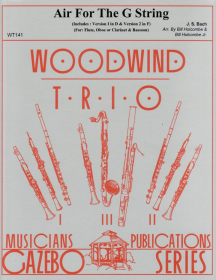
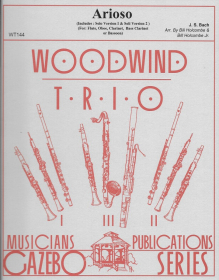






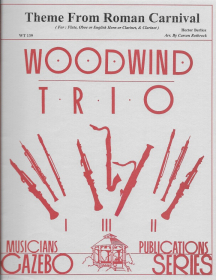

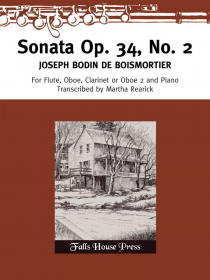
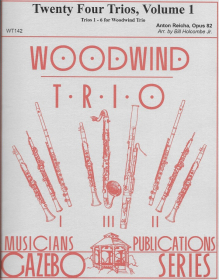

![Mayr, GS :: 12 Bagatelle a 3 [12 Bagatelles for 3]](http://www.flute4u.com/var/images/product/262.280/P/D009790206203817_d.jpg)

![Mozart, WA :: Eine Kleine Nachtmusick [A Little Night Music]](http://www.flute4u.com/var/images/product/262.280/P/700000000MPWT129_d.jpg)

